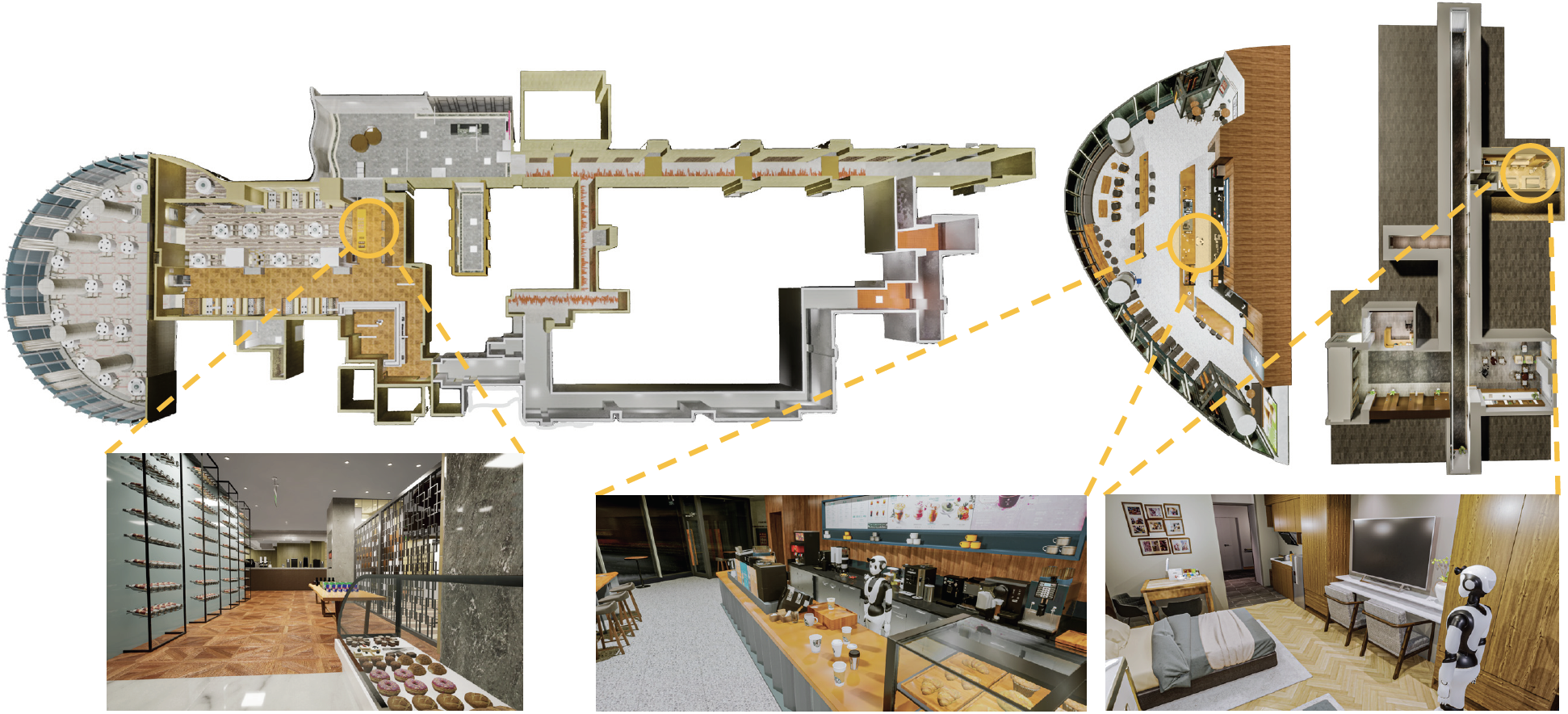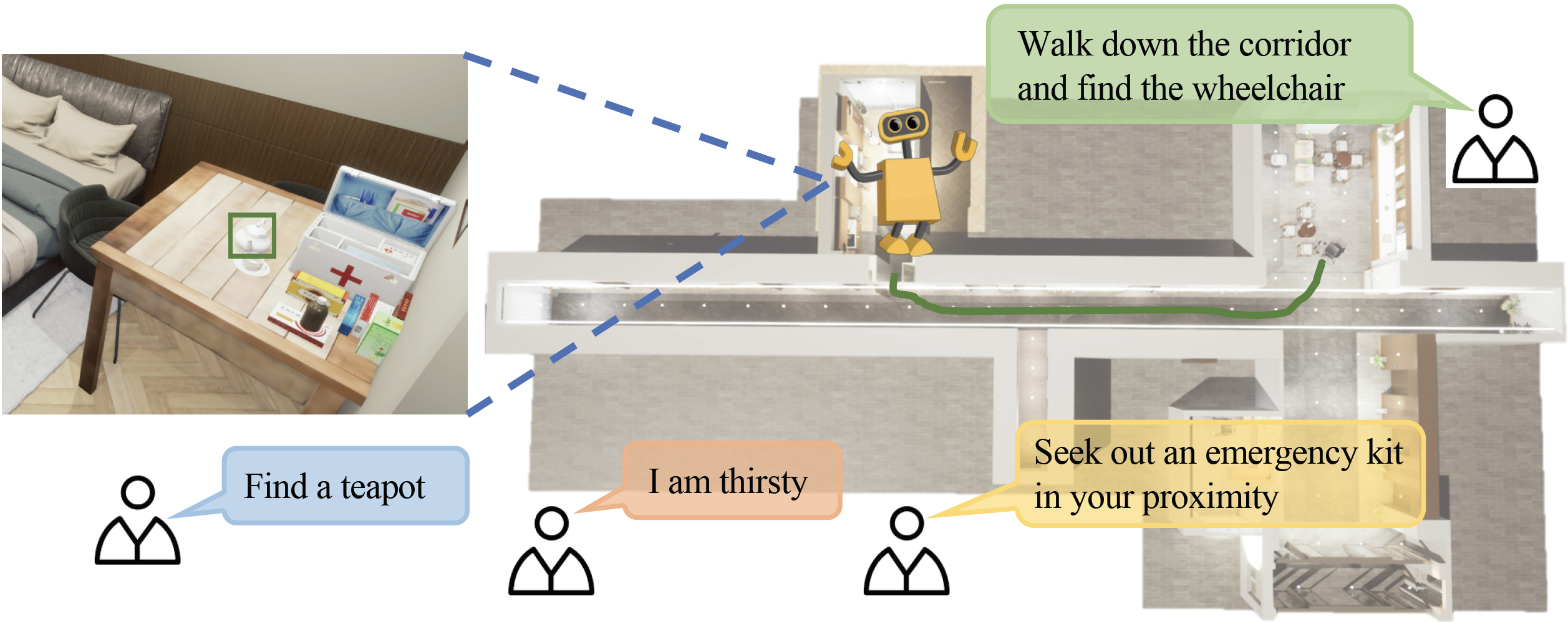This repository is the official PyTorch implementation of MO-VLN.
MO-VLN: A Multi-Task Benchmark for Open-set Zero-Shot Vision-and-Language Navigation
Xiwen Liang*,
Liang Ma*,
Shanshan Guo,
Jianhua Han,
Hang Xu,
Shikui Ma,
Xiaodan Liang
*Equal contribution
🚀🚀[8/17/2023]v0.2.0: More assets!2 new scenes,50 new walkers,954 new objects,1k+ new instructions
We have released 
- Support for grabbing and navigation tasks.
- Added many different walker states, including 50 unique walkers across gender, skin color, and age groups, with smooth walking or running motions.
- Added walker control interface. This interface supports:
- Selecting the walker type to generate
- Specifying where walkers are generated
- Setting whether they move freely
- Controlling the speed of their movement
- Added 1k+ instructions to our four tasks.
- We modeled an additional 954 classes of models to construct the indoor scene.
- Two new scenes have been added, bringing the total to five:
[6/18/2023]v0.1.0: 3 scenes,2165 objects, real light, shadow characteristics, and support instruction tasks with four tasks
We have released 
- Built on UE5.
- 3 scene types:
- Café -- Modelled on a 1:1 ratio to a Café
- Restaurant -- Modelled on a 1:1 ratio to a restaurant
- Nursing Room -- Modelled on a 1:1 ratio to a Nursing Room
- We handcrafted 2,165 classes of models at a 1:1 ratio to real-life scenarios to construct these three scenes. These three scenes were ultimately constructed from a total of 4,230 models.
- We selected 129 representative classes from the models built and supported navigation testing. Among them, 54 classes are fixed within the environment, while 73 classes support customization by users.
- With real light and shadow characteristics
- Support instruction tasks with four tasks:
- goal-conditioned navigation given a specific object category (e.g., "fork");
- goal-conditioned navigation given simple instructions (e.g., "Search for and move towards a tennis ball");
- step-by-step instructions following;
- finding abstract objects based on high-level instruction (e.g., "I am thirsty").
MO-VLN provides four tasks: 1) goal-conditioned navigation given a specific object category (e.g., "fork"); 2) goal-conditioned navigation given simple instructions (e.g., "Search for and move towards a tennis ball"); 3) step-by-step instruction following; 4) finding abstract object based on high-level instruction (e.g., "I am thirsty"). The earlier version of our simulator covers three high-quality scenes: cafe, restaurant, and nursing house.
-
Installing the simulator following here.
-
Installing GLIP.
-
Installing Grounded-SAM.
Clone the repository and install other requirements:
git clone https://github.com/liangcici/MO-VLN.git
cd MO-VLN/
pip install -r requirements.txt
-
Downloading original datasets from here.
-
Generate data for ObjectNav (goal-conditioned navigation given a specific object category).
python data_preprocess/gen_objectnav.py --map_id 3
map_id indicates specific scene: {3: Starbucks; 4: TG; 5: NursingRoom}.
The implementation is based on frontier-based exploration (FBE). Exploration with commonsense knowledge as in our paper is based on ESC, which is not allowed to be released. dataset/objectnav/*.npy are knowledge extracted from LLMs, and can be used to reproduce exploration with commonsense knowledge.
Run models with FBE:
- For ObjectNav:
python zero_shot_eval.py --sem_seg_model_type glip --map_id 3
- The Semantic Mapping module is based on SemExp.
- Added more walker states.
- Added walker control interface.
- Provide more classes of generative objects.
- Construct complex tasks involving combined navigation and grasping.
- 10+ scenes are under construction and will be updated successively in the future.
- Generate high-quality instruction-ground truth pairs for the newly constructed scenes.
- Continue to update the simulator's physics engine effects to achieve more realistic dexterous hand-grabbing effects
- Adding more interactive properties to objects in the environment, such as a coffee machine that can be controlled to make coffee.
@article{liang2023mo,
title={MO-VLN: A Multi-Task Benchmark for Open-set Zero-Shot Vision-and-Language Navigation},
author={Liang, Xiwen and Ma, Liang and Guo, Shanshan and Han, Jianhua and Xu, Hang and Ma, Shikui and Liang, Xiaodan},
journal={arXiv preprint arXiv:2306.10322},
year={2023}
}







